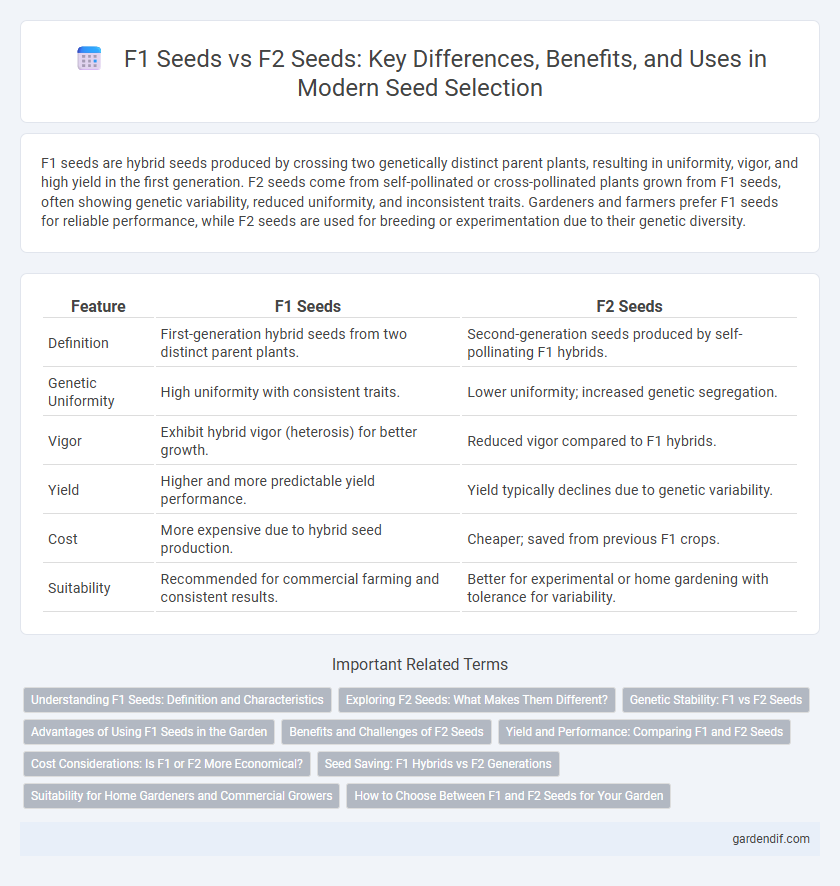
F1 seeds vs F2 seeds Illustration
F1 seeds are hybrid seeds produced by crossing two genetically distinct parent plants, resulting in uniformity, vigor, and high yield in the first generation. F2 seeds come from self-pollinated or cross-pollinated plants grown from F1 seeds, often showing genetic variability, reduced uniformity, and inconsistent traits. Gardeners and farmers prefer F1 seeds for reliable performance, while F2 seeds are used for breeding or experimentation due to their genetic diversity.
Table of Comparison
| Feature | F1 Seeds | F2 Seeds |
|---|---|---|
| Definition | First-generation hybrid seeds from two distinct parent plants. | Second-generation seeds produced by self-pollinating F1 hybrids. |
| Genetic Uniformity | High uniformity with consistent traits. | Lower uniformity; increased genetic segregation. |
| Vigor | Exhibit hybrid vigor (heterosis) for better growth. | Reduced vigor compared to F1 hybrids. |
| Yield | Higher and more predictable yield performance. | Yield typically declines due to genetic variability. |
| Cost | More expensive due to hybrid seed production. | Cheaper; saved from previous F1 crops. |
| Suitability | Recommended for commercial farming and consistent results. | Better for experimental or home gardening with tolerance for variability. |
Understanding F1 Seeds: Definition and Characteristics
F1 seeds are the first generation offspring resulting from a cross between two genetically distinct parent plants, offering uniformity in traits such as size, vigor, and yield. These seeds exhibit hybrid vigor or heterosis, which enhances disease resistance, growth rate, and overall productivity compared to their F2 counterparts. Understanding the genetic stability of F1 seeds is crucial as F2 seeds, derived from self-pollinating F1 plants, often show increased variability and trait segregation.
Exploring F2 Seeds: What Makes Them Different?
F2 seeds are the second-generation offspring produced by self-pollinating or crossing F1 hybrid plants, exhibiting greater genetic variation compared to the uniform F1 seeds. This variation results in diverse traits such as plant height, yield, and resistance, making F2 seeds less predictable but valuable for breeding programs aiming to develop new cultivars. Understanding the genetic segregation in F2 seeds is essential for farmers and breeders focused on selecting desirable characteristics for crop improvement.
Genetic Stability: F1 vs F2 Seeds
F1 seeds exhibit high genetic stability due to their hybrid vigor, consistently expressing desired traits such as uniformity, yield, and disease resistance. In contrast, F2 seeds show genetic segregation, leading to variability in plant characteristics and reduced predictability of performance. This genetic instability in F2 seeds makes them less suitable for commercial farming where uniformity and reliability are critical.
Advantages of Using F1 Seeds in the Garden
F1 seeds offer superior hybrid vigor, resulting in higher germination rates, uniform plant growth, and increased resistance to pests and diseases compared to F2 seeds. These seeds produce plants with predictable traits, ensuring consistent fruit size, color, and yield, which is essential for maintaining garden quality and productivity. Using F1 seeds enhances overall garden efficiency by reducing the need for chemical interventions and minimizing crop losses.
Benefits and Challenges of F2 Seeds
F2 seeds offer genetic diversity that can enhance resilience against pests, diseases, and environmental stresses, providing farmers with the potential for more adaptable crops. However, the variability in plant traits requires careful selection and management, as F2 offspring often exhibit inconsistent quality and yield compared to uniform F1 hybrids. Utilizing F2 seeds demands a deeper understanding of plant genetics to maximize benefits while mitigating challenges linked to unpredictable performance.
Yield and Performance: Comparing F1 and F2 Seeds
F1 seeds consistently deliver higher yield and superior performance due to their hybrid vigor, resulting in uniform plant growth and increased resistance to pests and diseases. In contrast, F2 seeds often exhibit genetic variability, leading to lower and unpredictable yields with inconsistent traits. Farmers seeking maximum productivity typically prefer F1 seeds for their reliability and enhanced crop quality.
Cost Considerations: Is F1 or F2 More Economical?
F2 seeds are generally more economical than F1 seeds due to their lower initial purchase price, making them a cost-effective choice for large-scale planting. However, F1 seeds often exhibit higher vigor and uniformity, leading to better yield and quality, which can offset their higher cost over time. When evaluating cost considerations, the balance between seed price and crop performance determines whether F1 or F2 seeds provide greater overall economic value.
Seed Saving: F1 Hybrids vs F2 Generations
F1 hybrid seeds offer uniformity and vigor due to controlled parentage, but saving seeds from F1 plants results in F2 generations with genetic variability and unpredictable traits. F2 seeds often exhibit a wide range of characteristics, including reduced yield and vigor compared to F1 hybrids, making them less reliable for consistent crop production. Seed saving from F2 generations requires careful selection and patience to stabilize desired traits over multiple planting cycles.
Suitability for Home Gardeners and Commercial Growers
F1 seeds offer hybrid vigor and uniformity, making them ideal for commercial growers seeking consistent crop quality and higher yields. Home gardeners may find F2 seeds suitable for saving seeds and exploring plant diversity, though these seeds exhibit more variation and less predictability. Choosing between F1 and F2 seeds depends on the need for reliability and yield versus seed saving and genetic diversity.
How to Choose Between F1 and F2 Seeds for Your Garden
F1 seeds, or first-generation hybrids, offer uniformity, vigorous growth, and higher yields, making them ideal for gardeners seeking predictability and consistent quality. F2 seeds, produced by self-pollinating F1 plants, exhibit greater genetic variation, which can lead to unique traits but less uniformity and potential reduction in vigor. Choosing between F1 and F2 seeds depends on your preference for reliability and performance versus experimenting with genetic diversity to develop new varieties in your garden.
F1 seeds vs F2 seeds Infographic

 gardendif.com
gardendif.com